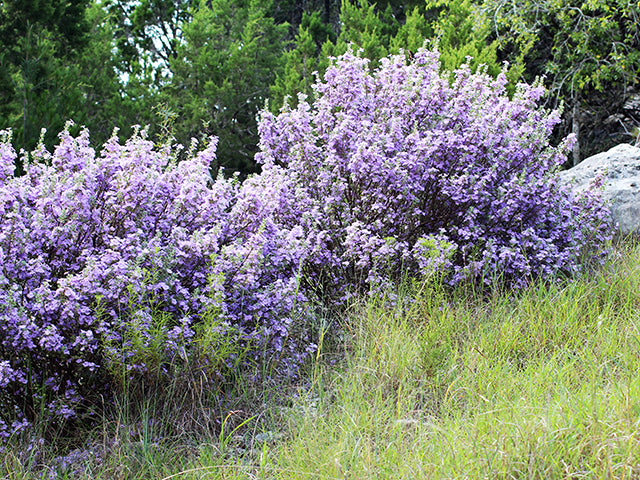Green Texas Sage (Leucophyllum frutescens)
Green Texas Sage (Leucophyllum frutescens)
11 in stock
Couldn't load pickup availability
Leucophyllum frutescens (Berl.) I.M. Johnst.
Cenizo, Purple Sage, Texas Ranger, Texas Barometer Bush, Texas Silverleaf, Texas Sage, Silverleaf
Scrophulariaceae (Figwort Family)
Synonym(s): Terania frutescens
USDA Symbol: LEFR3
A gray shrub with leaves densely covered with stellate, silvery hairs and bright pink-lavender, bilaterally symmetrical flowers borne singly in crowded leaf axils. Typically a compact shrub, 2-5 ft. tall, Texas Barometer Bush or Cenizo occasionally reaches 10 ft. in height, and 4-6 ft. in width. Leaves silvery gray to greenish, soft to the touch, up to 1 1/4 inches long but mostly 1 inch or less, tapering more gradually to the base than to the rounded tip, margins smooth. Flowers violet to purple, sometimes pink, nearly bell shaped, and up to 1 inch in length and width, appearing intermittently from spring to fall. Fruit a small capsule.
As one travels east across southern Texas near the Mexican border, the olive green of Creosote Bush (Larrea tridentata) gives way to the gray of this species, with its display of bright pink-lavender flowers. These burst into bloom for only a few days at a time, in the summer and fall, depending on rainfall. The ashy appearance of the leaves, also described as silvery, white, or gray, is due to the millions of tiny hairs covering them. A grouping of several individuals makes a good screen or hedge. There are many nice color selections and cultivars. This and other Leucophyllum species are popular water-conserving ornamentals in the Southwest.
Plant Characteristics
Habit: Shrub
Root Type: Tap
Leaf Retention: Evergreen
Leaf Arrangement: Alternate , Opposite
Leaf Complexity: Simple
Leaf Shape: Elliptic , Obovate
Leaf Pubescence: Stellate , Tomentose
Leaf Margin: Entire
Leaf Apex: Obtuse
Leaf Base: Cuneate
Breeding System: Flowers Unisexual , Monoecious
Inflorescence: Axillary
Fruit Type: Capsule
Size Notes: Up to about 10 feet tall, often shorter.
Leaf: Blue-gray, green, whitish gray, silvery
Flower: Flowers 1 inch wide
Bloom Time: Jan , Feb , Mar , Apr , May , Jun , Jul , Aug , Sep , Oct , Nov , Dec
Bloom Notes: Several months of periodic flowering. Often flowers after a few summer showers, which is why one of its common names is barometer bush.
Distribution
USA: TX
Native Distribution: In TX, Rio Grande Plain, s. Trans-Pecos, & Edwards Plateau, south to Nuevo Leon in Mexico
Native Habitat: Ditches, Ravines, Depressions, Hillsides, Slopes
Growing Conditions
Water Use: Low
Light Requirement: Sun , Part Shade
Soil Moisture: Dry
Cold Tolerant: yes
Heat Tolerant: yes
Soil Description: Rocky, well-drained soils. Limestone-based, Sandy, Sandy Loam, Medium Loam, Clay Loam, Clay, Caliche type
Conditions Comments: According to legend, cenizo tends to bloom in conjunction with rainfall. Cenizo is easy to grow so long as it has good drainage. Though this species is the most irrigation-tolerant of the genus, it is susceptible to cotton root rot if soil does not have good drainage and remains moist. Humidity and high night temperatures are lethal. Cenizos should not be fertilized or over-watered. Drought- and heat-tolerant. During very cold winters, may lose a few leaves.
Benefit
Use Ornamental: An evergreen shrub that can be sheared as a hedge with attractive foliage and showy masses of small flowers.
Use Wildlife: Nectar-insects, Nesting site, Cover.
Conspicuous Flowers: yes
Interesting Foliage: yes
Attracts: Butterflies
Larval Host: Theona Checkerspot, Calleta silkmoth
Deer Resistant: High
Image Information
Photographer: Schroeder, SusanCity: Camp Wood
County: Real
State: TX
Location Notes: Roaring Springs Ranch
Accession date: 2025-09-08
Filename: SMS_IMG0774.JPG
Slide Index: SMS_LEFR3-20160828-02.jpg
Restrictions: Unrestricted
Collection: Wildflower Center Digital Library
Original Format: Digital
Orientation: Landscape
Shot: Flowering plants.
Date Taken: 2016-08-28
NPIN Image Id: 184833


